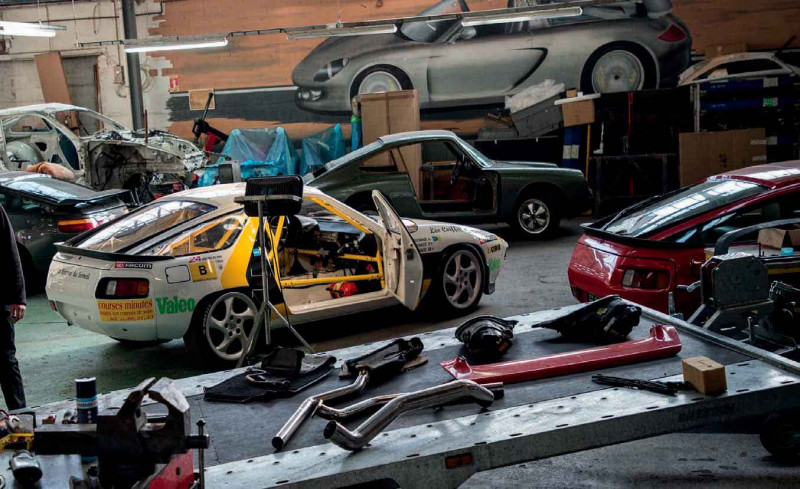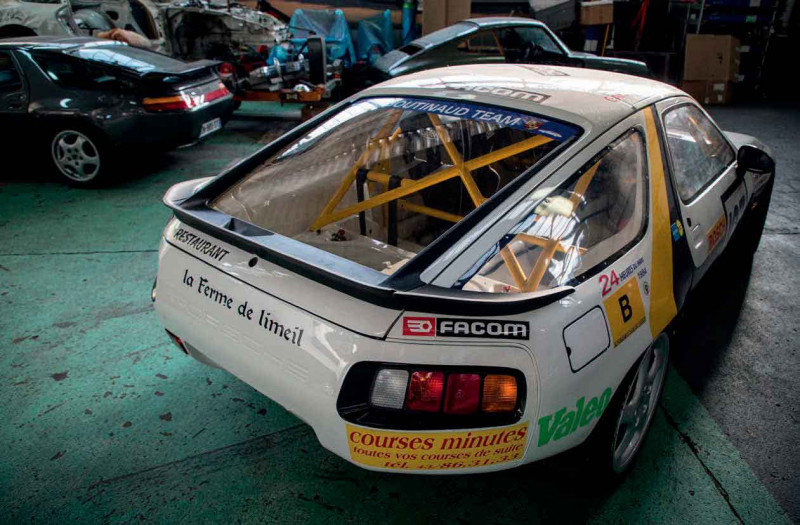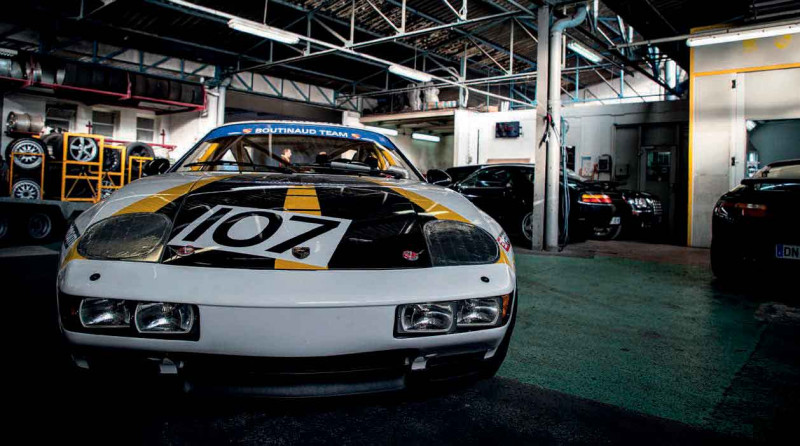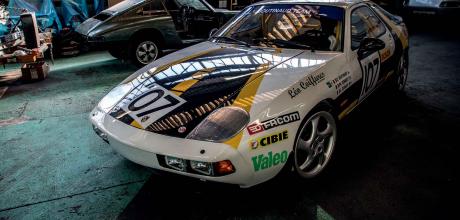The only 1983 Porsche 928 S to compete at Le Mans
Raymond Boutinaud recently restored the one and only 928 to contest the 24 Hours of Le Mans. We take a trip to his workshop and check out this legendary ‘land shark’ for ourselves… Words Robb Pritchard. Photography Robb Pritchard, Porsche, Raymond Boutinaud Racing.
SARTHE SHARK
Think Porsche and Le Mans in the early 1980s and the utter dominance of the Rothmans-liveried Group C 956s spring to mind. In Group B, however, behind stacks of well-developed 911s, there was an altogether more unusual sight to behold: in 1983 and 1984, Raymond Boutinaud, a driver living local to Le Mans, entered a lone 928 S into the race. This ‘land shark’ has gone down in history as the only 928 to ever to participate in the daylong bash at Circuit de la Sarthe. And it did so twice.

Powered by the 4.7-litre variant of the front-mounted, water-cooled M28 V8, Boutinaud’s Porsche finished twenty-first overall in 1983, dropping a place to finish twenty-second overall a year later. After these consecutive outings, the car was retired from racing and subsequently put into storage for three decades. In 2015, Boutinaud decided it was time to ditch the dust covers with a view to restoring the car to its former glory. Consequently, following a three-year nut-and-bolt rebuild this historically significant 928 S was exhibited at the Le Mans Classic in 2018.
THE SIDE-EXIT PIPES IN USE ON THE 928 AT LE MANS IN 1983 PROVED TO BE UNCOMFORTABLY LOUD FOR THE DRIVERS
Boutinaud began tuning and racing 911s way back in the 1970s. On the outskirts of Paris, he’d established his own workshop servicing and modifying customer road and race cars. In 1982, he splashed out and bought himself a then new 928 S and, as most performance car owners do, he enjoyed punishing his Porsche on track days. Liking the M28 bent eight’s near 300bhp, big torque and his new toy’s handling, he began to wonder what it would be like as a race car if put on a diet and treated to concentrated chassis tuning. He came to the conclusion the 928 would be able to hold its own against the more nimble 911s he’d witnessed strutting their stuff at Le Mans. Automobile Club de l’Ouest (ACO, the Le Mans organising body) liked the idea of adding variety to the grid and, more importantly, Porsche’s motorsport division was keen on the idea of privateers developing the 928 for racing. Indeed, Jürgen Barth stepped forward to oversee the project, but even then, building a Le Mans machine from a car used for daily driving promised to be especially challenging, not least because the ACO didn’t provide Boutinaud with confirmation of entry to the 1983 24 Hours of Le Mans until April, leaving just two months to complete the build.

LEICHT WEIGHT
The first job was to ditch as much weight as possible. Out went the interior, seats, all the superfluous soundproofing and lining, thereby ensuring the inside of the shell was bare and the doors little more than frames with a thin outer skin. Most of the dashboard was dismissed, save for the original instrument cluster and steering wheel. Pretty much the whole wiring loom proved surplus to requirements and was therefore binned, a move shifting a not insignificant thirty kilos. In its place, a much lighter loom was made, catering for basic engine and instrument functionality, as well as lighting for the famous Le Mans nighttime sessions. In total, Boutinaud was able to rid his 928 of more than four hundred kilos. I am particularly pleased about this fact — when pushing the car into position for the photographs on these pages, it rolled over my foot. Ouch. In fact, when Boutinaud had finished binning bulk, his 928 was so light, twenty kilos of ballast was required to bring the car up to the class minimum weight!
The engine too was stripped of anything deemed unnecessary. The block was sent to Mahle, where the cylinder shafts were coated with Nikasil, an anti-friction covering. The company’s engineers also produced a bespoke set of forged pistons for the car’s thumping V8. This modification was permitted for Le Mans, providing the parts maintained the same dimensions as those being removed.
The camshaft, meanwhile, was made to Boutinaud’s design by a local engineering firm, where subtle adjustments were introduced to slightly alter valve lift and the time of opening. The cylinder heads were ported and polished in order to improve airflow into the cylinders.

The car’s brakes are the same as those fitted to the 917 and were used to great effect on the limited-volume 911 SC RS being produced when Boutinaud’s build was getting underway. Elsewhere, the suspension was made by Bilstein as a custom creation specifically for his 928’s attack of Sarthe’s hallowed asphalt. Porsche helped line up these service providers, but there was no financial support — Boutinaud had to pay for everything himself. That said, taking no risks as far as driver safety was concerned, the dimensions of the roll cage were calculated by Porsche, which had the aluminium tubework made to order and sent direct to Boutinaud’s base near Paris for installation. When it came to paintwork, he was too busy with client projects to give much consideration to the finish of his modified ride, which is why he told his trusted bodywork specialist to “produce something eye-catching.” The resulting light green and purple crosshatch wasn’t quite what he was hoping for, and he soon learned the wizards at Weissach weren’t exactly impressed, either. “It was what it was,” he shrugs.
Co-drivers were easy to find as a consequence of word spreading about a Porsche-supported private 928 entry to Le Mans. Of all those who expressed their desire to join the party, Boutinaud chose Formula Three and Formula Renault driver, Patrick Gonin. Completing the line-up, Alain le Page was known as a competent driver, and, crucially, brought important sponsorship to the team. The stage was set.
The 928 and its trio of speed merchants made it to the race without a hitch, though they weren’t exactly welcome in the Rothmans VIP suite and were served with strict instructions to keep out of the way of the works 956s on the track. Perhaps a little too cautious as a consequence of this warning, the Boutinaud squad qualified at the back of the pack, but a lot can happen in a twenty-four-hour race, which is why none of the team was concerned about starting the event a few metres behind the class-leading BMW M1 and half a dozen 911s. The same calm attitude was adopted when the 928 was held at the back of the field as the first few hours of the race passed by. “Everyone knows Le Mans is a race of attrition. This was especially true of the event back when I was campaigning the 928,” Boutinaud explains. All was going to plan, then? Well, sort of. Smooth running was interrupted in the early evening when le Page span the car at Indianapolis. Boutinaud still doesn’t know exactly what happened (he tells us le Page never fully explained the circumstances surrounding this wobble), though when the car pulled into the pits, it was discovered it was being hampered by a compromised front wheel hub assembly. Ordinarily, it would have been a thirty-minute repair, but Boutinaud had machined the centre to accommodate a bigger bearing. Unfortunately, he didn’t have a spare hub. What to do?!
GRAND THEFT AUTO
The team lost five hours in the pits, but the solution to get the car back on track (literally) is almost impossible to imagine taking place either then or now. So the story goes, one of Boutinaud’s team spotted a privately owned 928 in a nearby car park. One of the car’s wheels was ‘lovingly removed’ and its corresponding hub liberated, before being rushed to the on-site Bilstein mobile workshop where the suspension giant’s technicians machined the part to fit Boutinaud’s bigger bearing. Only then could his 928 return to action. Frustratingly, it was almost midnight when it hit the track again.
The rest of the race went like clockwork (both literally and figuratively!) and the last fourteen hours were an amazing display of Porsche performance and reliability. Even though the car finished outside of points classification for being too many laps behind the class leaders, when Boutinaud’s 928 crossed the finish line at 4pm on the Sunday, it was Porsche which sent champagne. In fact, Porsche was so impressed by the potential of the 928 Le Mans project, Barth and his colleagues invited Boutinaud to run again in 1984. He knew his 928 could finish well if afforded a clean run, belief which saw him agree to return to Le Mans in accordance with Porsche’s wishes. The main improvement he wanted was more power, but it’s a hard thing to extract from a normally aspirated engine making use of a mechanical fuel injection system, especially when the main parameter for endurance racing is reliability. Another modification he wanted to adopt was a bespoke exhaust with its exit at the rear — the side-exit pipes in use on the 928 at Le Mans in 1983 proved to be uncomfortably loud for the drivers. For 1984’s event, Boutinaud also took charge of the paint scheme. The result was the white, black and yellow livery seen on the car today.
A couple of old friends, Gilles Guinard and Philippe Renault, were drafted in as the required second and third drivers. The outcome of their combined efforts was a slight improvement on the previous year insofar as the 928 qualified second from last. Any optimism was swiftly dampened, however, when the car sprang a head gasket leak early on. Changing the part it in the pits was considered a job likely to take many hours, which is why Boutinaud instead tried to manage the situation by topping up the coolant at every fuel stop, and by instructing Guinard and Renault to keep a lid on high revs. Obviously, this meant the Porsche was much slower than it should have been, though there was no sign of this ailment down the long Mulsanne Straight. This was a few years before the speed-restricting chicanes we love to hate were installed and the 928 surprised many spectators by hitting 186mph where the hugely more powerful Group C cars — not running at full stretch through the night — were clocking 211mph. To put this in perspective, the speed difference wasn’t dissimilar to what you’d witness between the slow and fast lanes on a motorway.
DOWN TO BUSINESS
Boutinaud is a reserved and rather humble guy and apologises for the lack of ‘bumper battles’ to report on. “The only nail-biting action,” he says, halfjoking, “was us hoping the car could be nursed around the track for the full twenty-four hours!” Constantly nervous the gasket leak would get worse and blow the engine, the team made it to dawn, managed to carry on to midday, before miraculously crossing the finish line four hours later. Granted, the 928 finished last, but this was still enough to bag third in class. This time around, the champagne was provided by ACO.
Thereafter, Barth was keen for Boutinaud to carry on competing with the 928 and offered significant development parts for installation, but these would have come at heavy financial cost. After an uncompetitive outing with the large Porsche on a French tarmac rally, he decided to follow the path of least resistance and jumped behind the wheel of a 911, though the 928 always held a special place in his heart. For this reason, despite taking up valuable space in the Raymond Boutinaud Racing workshop for more than thirty years, this Le Mans legend was never pilfered for parts or left to battle the elements.
On the occasion of its resurrection, the shell proved itself to be in near perfect condition. The same couldn’t be said of the paint, which required a bare metal strip and recoating. The Porsche-authored roll cage looks exactly the same as it did at the original point of installation, but motorsport safety rules have changed fairly significantly in the intervening three decades, which is why the part is now made from steel instead of aluminium. The old and long-overheated engine wasn’t in any fit state for refurbishment, but rather than fit a like-for-like replacement, Boutinaud sourced a thirty-two-valve five-litre 928 S4 V8 and increased it to 5.5-litres, meaning he finally achieved his dream of giving his precious Porsche more power. Indeed, close to 450bhp — thanks to fuel management software tuning — is now propelling this modern classic, with bespoke transmission components strengthening the 928 S gearbox and mating it to the S4 V8. Modern ‘twisties’ wrapped in Pirelli race rubber occupy all four corners, while the coilovers now benefit from H&R springs. An OMP race seat shares cabin space with an updated fire safety system.
This 928’s powertrain and appearance may have been subjected to OEM+ enhancements since the car’s star turn at Le Mans, but one thing remains true: it’s the only 928 to have participated in the 24 Hours of Le Mans. It was therefore the only 928 in attendance at the 2018 Le Mans Classic. Truly, one of a kind. Mr Boutinaud, we salute you.
Below Boutinaud’s invitation to participate at Le Mans in 1983. Above Ready to do battle once again, this fearsome 928 S benefits from a choice selection of OEM+ updates. Above Jürgen Barth was keen to see further development, but the cost of parts proved too expensive. Below Restoration work in progress at Boutinaud’s workshop.
Above The car’s livery raised a few eyebrows when unveiled in 1983 Below Wearing black and yellow stripes, the 928 returned to Sarthe in 1984.
Above As you’d expect, Boutinaud’s workshop plays host to a variety of 928s. Below Original engine has made way for an S4 V8 increased to a useful 5.5-litres


